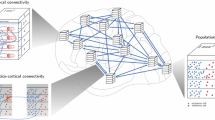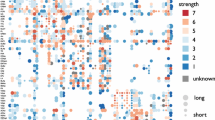Abstract
The cortex exhibits an intricate vertical and horizontal architecture, the latter often featuring spatially clustered projection patterns, so-called patches. Many network studies of cortical dynamics ignore such spatial structures and assume purely random wiring. Here, we focus on non-random network structures provided by long-range horizontal (patchy) connections that remain inside the gray matter. We investigate how the spatial arrangement of patchy projections influences global network topology and predict its impact on the activity dynamics of the network. Since neuroanatomical data on horizontal projections is rather sparse, we suggest and compare four candidate scenarios of how patchy connections may be established. To identify a set of characteristic network properties that enables us to pin down the differences between the resulting network models, we employ the framework of stochastic graph theory. We find that patchy projections provide an exceptionally efficient way of wiring, as the resulting networks tend to exhibit small-world properties with significantly reduced wiring costs. Furthermore, the eigenvalue spectra, as well as the structure of common in- and output of the networks suggest that different spatial connectivity patterns support distinct types of activity propagation.









Similar content being viewed by others
References
Abeles, M. (1991). Corticonics: Neural circuits of the cerebral cortex. Cambridge: Cambridge University Press.
Albert, R., & Barabási, A.-L. (2002). Statistical mechanics of complex networks. Reviews of Modern Physics, 74, 47–97.
Amir, Y., Harel, M., & Malach, R. (1993). Cortical hierarchy reflected in the organization of intrinsic connections in macaque monkey visual cortex. Journal of Comparative Neurology, 334, 19–46.
Attwell, D., & Laughlin, S. B. (2001). An energy budget for signaling in the grey matter of the brain. Journal of Cerebral Blood Flow & Metabolism, 21, 1133–1145.
Bassett, D. S., & Bullmore, E. (2006). Small-world brain networks. Neuroscientist, 12(6), 512–523.
Batschelet, E. (1981). Circular statistics in biology. London: Academic.
Binzegger, T., Douglas, R. J., & Martin, K. A. C. (2004). A quantitative map of the circuit of cat primary visual cortex. Journal of Neuroscience, 39(24), 8441–8453.
Binzegger, T., Douglas, R. J., & Martin, K. A. C. (2007). Stereotypical bouton clustering of individual neurons in cat primary visual cortex. Journal of Neuroscience, 27(45), 12242–12254.
Bonhoeffer, T., & Grinvald, A. (1991). Iso-orientation domains in cat visual cortex are arranged in pinwheel-like patterns. Nature, 353(6343), 429–431.
Bonhoeffer, T., & Grinvald, A. (1993). The layout of iso-orientation domains in area 18 of cat visual cortex: Optical imaging reveals a pinwheel-like organization. Journal of Neuroscience, 12(10), 4157–4180.
Bosking, W. H., Zhang, Y., Schofield, B., & Fitzpatrick, D. (1997). Orientation selectivity and the arrangement of horizontal connections in tree shrew striate cortex. Journal of Neuroscience, 17(6), 2112–2127.
Brunel, N. (2000). Dynamics of sparsely connected networks of excitatory and inhibitory spiking neurons. Journal of Computational Neuroscience, 8(3), 183–208.
Burkhalter, A., & Charles, V. (1990). Organization of local axon collaterals of efferent projection neurons in the rat visual cortex. Journal of Comparative Neurology, 302, 920–934.
Buzas, P., Kovacs, K., Ferecsko, A. S., Budd, J. M. L., Eysel, U. T., & Kisvarday, Z. F. (2006). Model-based analysis of excitatory lateral connections in the visual cortex. Journal of Comparative Neurology, 499, 861–881.
Buzsaki, G., Geisler, C., Henze, D., & Wang, X.-J. (2004). Interneuron diversity series: Circuit complexity and axon wiring economy of cortical interneurons. TINS, 27(4), 186–193.
Callaway, E. M., & Katz, L. C. (1990). Emergence and refinement of clustered horizontal connections in cat striate cortex. Journal of Neuroscience, 10(4), 1134–1153.
Chisum, H. J., & Fitzpatrick, D. (2004). The contribution of vertical and horizontal connections to the receptive field center and surround in v1. Neural Networks, 17, 681693.
Chklovskii, D. (2000). Optimal sizes of dendritic and axonal arbors in a topographic projection. Journal of Neurophysiology, 83, 2113–2119.
Chklovskii, D. B. (2004). Synaptic connectivity and neuronal morphology: Two sides of the same coin. Neuron, 43, 609–617.
DeLosRios, P., & Petermann, T. (2007). Existence, cost and robustness of spatial small-world networks. IJBC, 17(7), 2331–2342.
Denker, M., Timme, M., Diesmann, M., Wolf, F., & Geisel, T. (2004). Breaking synchrony by heterogeneity in complex networks. Physical Review Letters, 92, 074103.
Diesmann, M., Gewaltig, M.-O., & Aertsen, A. (1999). Stable propagation of synchronous spiking in cortical neural networks. Nature, 402(6761), 529–533.
Farkas, I. J., Derenyi, I., Barabasi, A.-L., & Vicsek, T. (2001). Spectra of real-world graphs: Beyond the semicircle law. Physical Review E, 64, 026704.
Fisher, N. I. (1993). Statistical analysis of circular data. Cambridge: Cambridge University Press.
Gilbert, C. D., & Wiesel, T. N. (1983). Clustered intrinsic connections in cat visual cortex. Journal of Neuroscience, 5, 1116–1133.
Gilbert, C. D., & Wiesel, T. N. (1989). Columnar specificity of intrinsic horizontal and corticocortical connections in cat visual cortex. Journal of Neuroscience, 9(7), 2432–2442.
Hellwig, B. (2000). A quantitative analysis of the local connectivity between pyramidal neurons in layers 2/3 of the rat visual cortex. Biological Cybernetics, 82, 111–121.
Johansson, C., & Lansner, A. (2007). Imposing biological constraints onto an abstract neocortical attractor network model. Neural Computation, 19, 1871–1896.
Johnson, D. M. G., Illig, K. R., Behan, M., & Haberly, L. B. (2000). New features of connectivity in piriform cortex visualized by intracellular injection of pyramidal cells suggest that primary olfactory cortex functions like association cortex in other sensory systems. Journal of Neuroscience, 20(18), 6974–6982.
Kaiser, M., & Hilgetag, C. C. (2004). Modelling the development of cortical systems networks. Neurocomputing, 58–60, 297–302.
Kalisman, N., Silberberg, G., & Markram, H. (2003). Deriving physical connectivity from neuronal morphology. Biological Cybernetics, 88(3), 210–218.
Kisvarday, Z. F., & Eysel, U. T. (1992). Cellular organization of reciprocal patchy networks in layer III of cat visual cortex (area 17). Neuroscience, 46, 275–286.
Koroutchev, K., & Korutcheva, E. (2006). Improved storage capacity of hebbian learning attractor neural network with bump formations. In LNCS (Vol. 4131, pp. 234–243).
Kriener, B., Helias, M., Aertsen, A., & Rotter, S. (2009). Correlations in spiking neuronal networks with distance dependent connections. Journal of Computational Neuroscience, 27, 177–200.
Kriener, B., Tetzlaff, T., Aertsen, A., Diesmann, M., & Rotter, S. (2008). Correlations and population dynamics in cortical networks. Neural Computation, 20, 2185–2226.
Kumar, A., Rotter, S., & Aertsen, A. (2008a). Conditions for propagating synchronous spiking and asynchronous firing rates in a cortical network model. Journal of Neuroscience, 28(20), 5268–5280.
Kumar, A., Schrader, S., Aertsen, A., & Rotter, S. (2008b). The high-conductance state of cortical networks. Neural Computation, 20(1), 1–43.
Levitt, J., & Lund, J. (2002). Intrinsic connections in mammalian cerebral cortex. In A. Schüz, & R. Miller (Eds.), Cortical areas: Unity and diversity (chap. 7, pp. 133–154). London: Taylor and Francis.
Lewis, D., Melchitzky, D., & Burgos, G.-G. (2002). Specificity in the functional architecture of primate prefontal cortex. Journal of Neurocytology, 31, 265–276.
Lohmann, H., & Rörig, B. (1994). Long-range horizontal connections between supragranular pyramidal cells in the extrastiate visual cortex of the rat. Journal of Comparative Neurology, 344, 543–558.
Lund, J., Yoshioka, T., & Levitt, J. (1993). Comparison of intrinsic connectivity in different areas of macaque monkey cerebral cortex. Cerebral Cortex, 3(2), 148–162.
Mehring, C., Hehl, U., Kubo, M., Diesmann, M., & Aertsen, A. (2003). Activity dynamics and propagation of synchronous spiking in locally connected random networks. Biological Cybernetics, 88(5), 395–408.
Melchitzky, D. S., Gonzale-Burgos, G., Barrionuevo, G., & Lewis, D. A. (2001). Synaptic targets of the intrinsic axon collaterals of supragranular pyramidal neurons in monkey prefontal cortex. Journal of Comparative Neurology, 430, 209–221.
Newman, M. E. J. (2003). The structure and function of complex networks. SIAM Review, 45(2), 167–256.
Ojima, H., & Takayanagi, M. (2004). Cortical convergence from different frequency domains in the cat primary auditory cortex. Neuroscience, 126, 203–212.
Ojima, H., Honda, C. N., & Jones, E. G. (1991). Patterns of axon collateralization of identified supragranular pyramidal neurons in the cat auditory cortex. Cerebral Cortex, 1, 80–94.
Pucak, M. L., Levitt, J. B., Lund, J. S., & Lewis, D. A. (1996). Patterns of intrinsic and associational circuitry in monkey prefrontal cortex. Journal of Comparative Neurology, 376, 614–630.
Roudi, Y., & Treves, A. (2004). An associative network with spatially organized connectivity. Journal of Statistical Mechanics: Theory and Experiment (P07010).
Roudi, Y., & Treves, A. (2008). Representing where along with what information in a model of a cortical patch. PLoS Computers in Biology, 4(3), e1000012.
Roxin, A., Brunel, N., & Hansel, D. (2005). The role of delays in shaping spatio-temporal dynamics of neuronal activity in large networks. Physical Review Letters, 94(23), 238103.
Rumberger, A., Tyler, C. J., & Lund, J. S. (2001). Intra- and inter-areal connectivity between the primary visual cortex V1 and the area immediately surrounding V1 in the rat. Neuroscience, 102, 35–52.
Schüz, A., & Braitenberg, V. (2002). The human cortical white matter: Quantitative aspects of cortico-cortical long-range connectivity. In A. Schüz, & R. Miller (Eds.), Cortical areas: Unity and diversity (chap. 16, pp. 377–385). London: Taylor and Francis.
Schüz, A., Chaimow, D., & Liewald, D. (2005). Quantitative aspects of corticocortical connections: A tracer study in the mouse. Cerebral Cortex, 16, 1474–1486.
Sporns, O., & Zwi, D. Z. (2004). The small world of the cerebral cortex. Neuroinformatics, 2, 145–162.
Stepanyants, A., Hirsch, J., Martinez, L. M., Kisvarday, Z. F., Ferecsko, A. S., & Chklovskii, D. B. (2008). Local potential connectivity in cat primary visual cortex. Cerebral Cortex, 18(1), 13–28.
Strogatz, S. H. (2001). Exploring complex networks. Nature, 410, 268–276.
Tetzlaff, T., Einevoll, G. T., & Diesmann, M. (2009). Synchronization and rate dynamics in embedded synfire chains: Effect of network heterogeneity and feedback. BMC Neuroscience, 10(Suppl 1):P258.
Tetzlaff, T., Morrison, A., Timme, M., & Diesmann, M. (2005). Heterogeneity breaks global synchrony in large networks. In Proceedings of the 30th Göttingen neurobiology conference.
Thomson, A. M., & Bannister, P. (2003). Interlaminar connections in the neocortex. Cerebral Cortex, 13, 5–14.
van Hooser, S. D., Heimel, J. A., Chung, S., & Nelson, S. N. (2006). Lack of patchy horizontal connectivity in primary visual cortex of a mammal without orientation maps. Journal of Neuroscience, 26(29), 7680–7692.
Voges, N. (2007). Statistical analysis of cortical networks based on neuroanatomical data. Ph.D. thesis, University of Freiburg.
Voges, N., & Perrinet, L. (2009). Phase space analysis of networks based on biologically realistic parameters. Journal of Physiology (Paris) (in press).
Voges, N., Aertsen, A., & Rotter, S. (2007). Statistical analysis of spatially embedded networks: From grid to random node positions. Neurocomputing, 70(10–12), 1833–1837.
Wallace, M. N., Kitzes, L. M., & Jones, E. G. (1991). Intrinsic inter- and intralaminar connections and their relationship to the tonotopic map in cat primary auditory cortex. Experimental Brain Research, 86(3), 527–544.
Watts, D. J., & Strogatz, S. H. (1998). Collective dynamics of small-world networks. Nature, 393, 440–442.
Acknowledgements
We thank Almut Schüz and Valentino Braitenberg for stimulating discussions. Special thanks to Johannes Hausmann and Sarah Jarvis for help and encouragement during writing. This work was funded by a dissertation grant to N.V. from the Institute for Frontier Areas of Psychology and Mental Health, Freiburg. Further support was received from the BMBF (grant 01GQ0420) and the EU (grant 15879, FACETS).
Author information
Authors and Affiliations
Corresponding author
Additional information
Action Editor: Alessandro Treves
Rights and permissions
About this article
Cite this article
Voges, N., Guijarro, C., Aertsen, A. et al. Models of cortical networks with long-range patchy projections. J Comput Neurosci 28, 137–154 (2010). https://doi.org/10.1007/s10827-009-0193-z
Received:
Revised:
Accepted:
Published:
Issue Date:
DOI: https://doi.org/10.1007/s10827-009-0193-z




